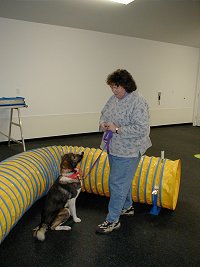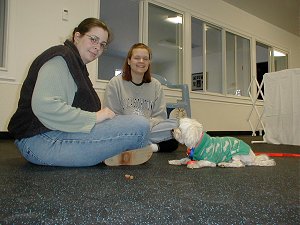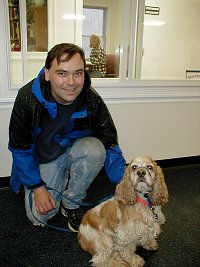The History
Upper Valley Humane Society started over 40 years ago as a foster care network. They purchased a small kennel in Plainfield, New Hampshire in 1972, but were crowded out by development, with new neighbors objecting to the barking dogs. Executive director Joan McGovern undertook the design of a new shelter. With a land swap facilitated by a benefactor, and the help of many donors and volunteers, they moved north to Enfield, near Dartmouth College, in 1991.
Upper Valley had a dedicated staff and community support, both financial and in the form of volunteers. They were doing a good job in the eyes of the community, taking care of strays, promoting spaying and neutering, caring well for the animals in the shelter, and finding new homes for an average of 45% of the animals they took in.
Until 1998 the shelter statistics remained fairly level. For example, in 1997, as in most previous years, UVHS took in about 1500 animals a year, divided about equally between dogs and cats with a sideline in potbellied pigs. They successfully adopted out about 40% of the adult dogs taken in and euthanized another 37%, largely for behavioral problems, including aggression-a problem familiar to all shelters.
The challenges
In fact all of the problems Upper Valley faced would be familiar to many other shelters. They were underfunded, understaffed, and overcrowded. Most of the volunteers had no real animal skills, certainly no way of dealing with behavior problems. The dogs barked incessantly, adding to the stress of the cats, the staff, the volunteers, and the dogs themselves. (Barking, as many shelter workers will testify, discourages adoption, because people dread walking into that uproar. At Upper Valley potential adopting families were fitted with earplugs before they toured the kennels.)
In 1998 a board member, Mary Taylor, an administrator in a nearby medical school, was hired fulltime as an administrator at the shelter. She found herself saddled with a task she hadn't expected: overseeing the volunteer program. She immediately began researching volunteer programs in other shelters, and struck gold in the nearby Monadnock Humane Society. Two Monadnock staff members, Bert Troughton and Rochelle Garfinkel, had gone to a Karen Pryor "Don't Shoot the Dog" seminar a couple of years earlier in Manchester, New Hampshire. They had become very excited about positive reinforcement and clicker training. Back at Monadnock they developed what they called the S.T.A.R. (Socialization & Training for Adoption Readiness) Volunteer program: an elite group of volunteers who could give special all-positive training to the most extreme and challenging dogs.
The two shelters swapped information and ideas. At Upper Valley, Mary realized she hated seeing the volunteers being dragged down the road by one dog after another as each dog got out of the kennel for its daily five minute walk. Shelter Manager Nina McCoy wasn't sure the volunteers helped the dogs at all; it seemed as if they went back into the kennels more charged up and barky than ever.
Solutions:
1: Clicker Training
The first step was to find a clicker trainer. In 1998 Upper Valley staffers met Dee Ganley, an enthusiastic clicker instructor. Dee agreed to do some consulting and perhaps give some demonstrations to Upper Valley volunteers. Mary Taylor asked Dee to first give a demonstration to the staff so they'd have some idea of what was going on. The dog they chose was a huge, active, unmanageable Rottweiler mix named Roscoe. Roscoe had some fear and aggression issues. He literally bounced off the walls, and began his session with Dee by launching himself at the treat bowl on top of a tall bookcase.

A reporter wrote later, "Within a short time, Dee had him sitting and politely going around the room to meet the staff. The shelter hired her to come in three days a week to work with the animals. But the training required more than that. The dogs would lapse back to their old habits in between sessions. So Ms. Ganley and the shelter set up a comprehensive program throughout the shelter. Today, the kennel staff and all the volunteers have clicker skills. The dogs in the shelter are taught basic manners-waiting at the kennel door, sitting on command, staying during distractions. So not only do the animals leave the shelter with a degree of training, making them better pets, they're much easier for staff to handle and work on."
Dee quickly put clicker methods in place to reduce the barking. Noisy dogs were ignored by shelter workers; quiet dogs got a click and a tossed treat. The dogs got their dinners when they sat quietly at the door; they all learned to do that. Staff could incorporate these small changes into their daily routine, with big results: peace and quiet. "One day in 1999," Mary Taylor recalls, "we realized that we weren't giving ear plugs to the adopters any more. We didn't need to. In fact we couldn't even remember where we had put them."
Dee then changed the dog walkers' duties to fewer dogs and longer walks. Maybe not every dog got out every day, but when they did, they got some real exercise and came back tired and happy. And, best of all, they developed a learning program for the volunteers.
2. The S.T.A.R. Program
All volunteers have the option, now, of making each trip to Upper Valley a learning experience. S.T.A.R. volunteers may progress from basic dog walking (putting on the Gentle Leader, teaching the dog a relaxed down and to wait at the door) through three more levels of interaction with the dogs. At the highest level, S.T.A.R. volunteers may become training assistants working with more challenging dogs; they may become apprentice trainers, helping teach clicker training to the general public; and they may become peer trainers and mentors of beginning volunteers.
A recent volunteer focus group reported that the opportunity not just to be with the animals but to really learn something was extremely reinforcing. Coming to Upper Valley has become an exciting thing to do. One result, according to Taylor, is a noticeable upgrade in the quality of people applying. In the past, volunteers were often rather needy people, more tuned in to their own desire to love the animals than to what the animals needed, themselves.

Now volunteers really learn to work with the animals, beginning with simple kennel clicking for calm. Kennel work is a wonderful way, Dee Ganley points out, for both dogs and volunteers to get the concept of the clicker exchange, without having to struggle with leashes and outdoor distractions.
S.T.A.R. Volunteers also take their roles in relationship to the animals and the organization very seriously. An original S.T.A.R. volunteer seeded the money for outdoor play cages for the dogs, and for a new training building. Current S.T.A.R. volunteers have recently set up a Yahoo! Chat group to share information about the dogs they work with at the shelter.
Mary Taylor recalls another great moment, shortly after the program began: the day they ceremoniously piled up and junked all the metal collars (choke chains) in the shelter and threw them away, replacing them with martingales (The Promise Collar), Gentle Leaders--and of course, clicks and treats.
The Outcome
In 2001, the most recent year for which complete statistics exist, the shelter took in about 1500 animals, as in previous years. The successful adoption rate for adult dogs had gone from an average of 40% before the program started, to almost 60%. The euthanasia rate dropped nearly in half, from a high of 37% to a low of 20%. In 1998, the year the program began, of the dogs that were euthanized over half were put down for behavior problems other than aggression. By 2000, of those dogs that were euthanized, only 14% had intractable behavior problems other than aggression. The very simple switch to clicker was making a huge difference, not so much in what the dogs knew, as in how they responded to people. And it was paying off.
In May of 2002 Upper Valley Humane Society opened the doors of a beautiful new training building, offering a wide variety of 100% clicker classes to the general public

(veterinary manners; puppy/family fun; agility for confidence; teenage dog fun classes; and more.) The training facility of course also provides room for S.T.A.R. volunteers to work with all the shelter dogs. Many reinforcement programs and policies were instituted within the organization, for staff and volunteers and even the board members.
Upper Valley has become a beacon for other organizations, hosting seminars for the American Humane Association and Humane Society of the United States, and teaching programs to other shelters in the region. The ASPCA recently recognized UVHS as one of six shelters nationally with the most innovative adoption programs, now featured in their "Future Trends in Animal Sheltering" program.
The innovators at Upper Valley are now working to record, coordinate, describe, and pin down all the procedures they have put in place, so that nothing is dependent on the presence of any one individual person. "We are a LEARNING organization," Mary Taylor says. "We want to make sure that what Dee Ganley and Nancy Lyon and the rest of our staff have created here is not dependent on the presence of any one individual. If we're not here, the programs can still go forward."
To the benefit of other shelters-and adopters-and a lot of dogs-not to mention cats, and about two dozen clean, calm, and clicker-trained potbellied pigs.


Post new comment